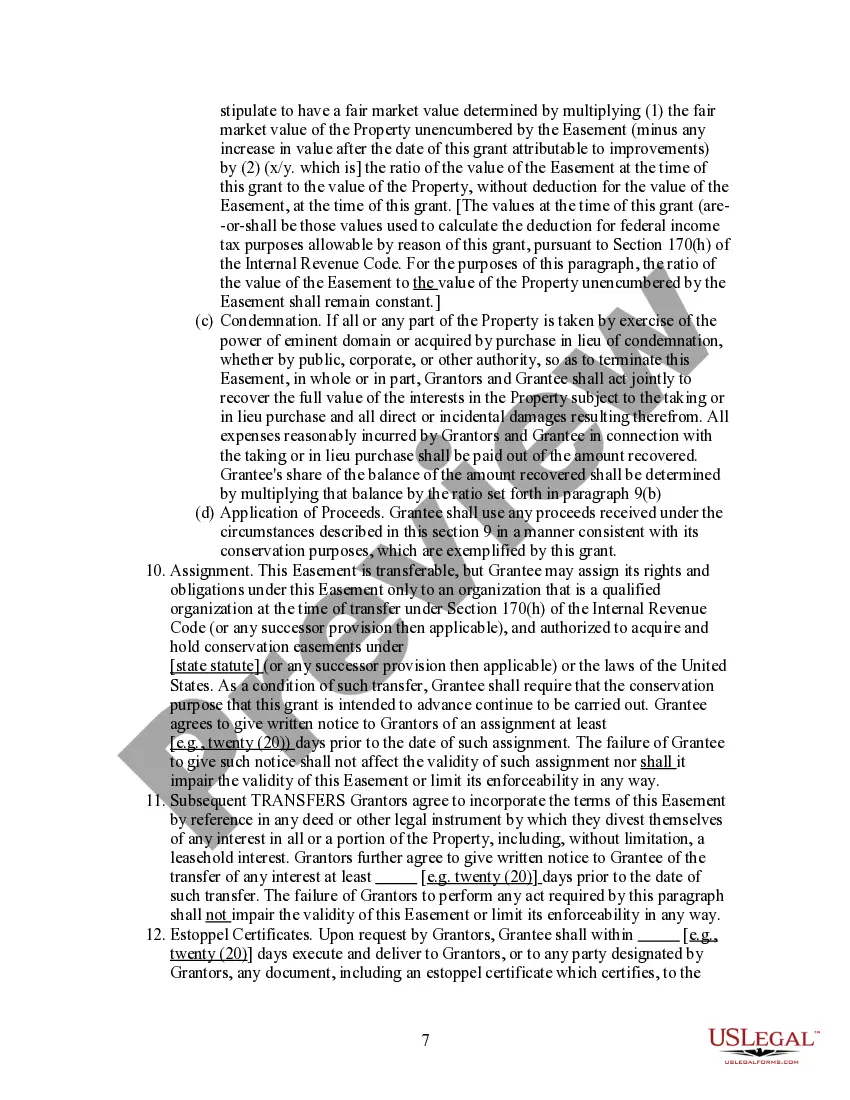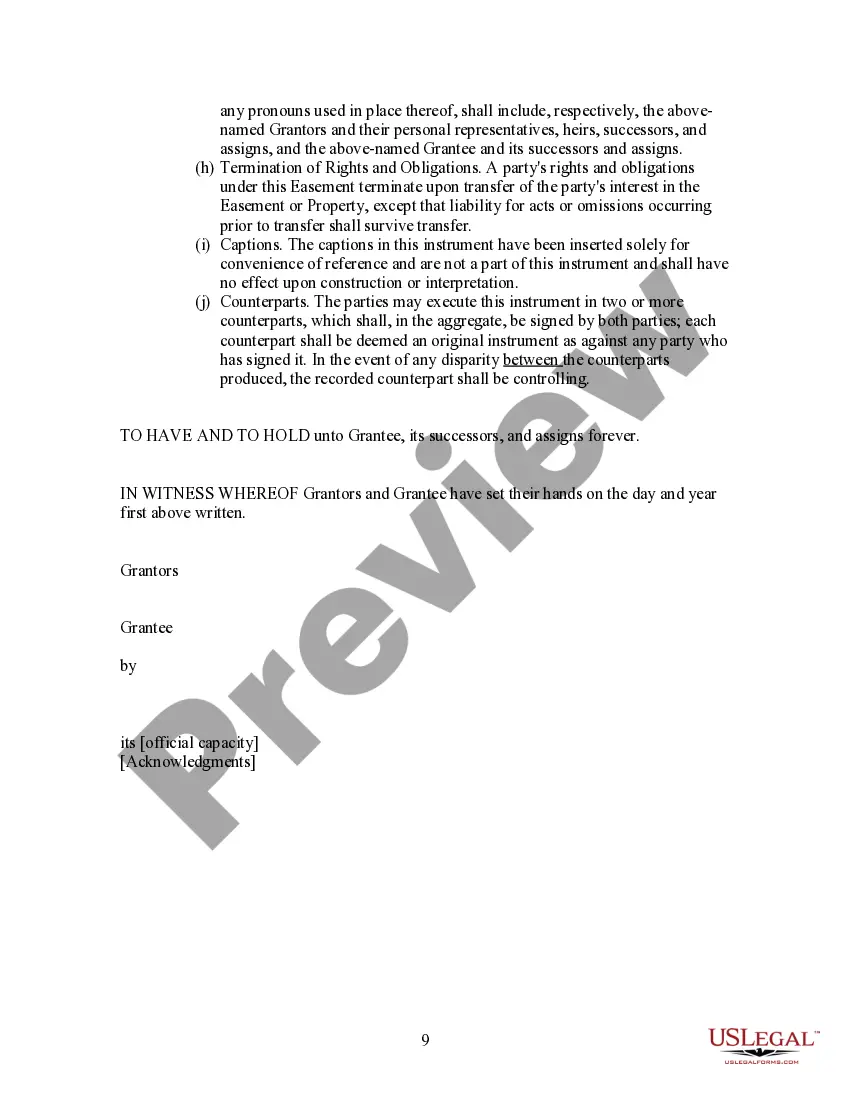A Kentucky Deed of Conservation Easement is a legally binding document that allows landowners to voluntarily protect and conserve their property's natural, scenic, or historic features for future generations. Conservation easements in Kentucky are an effective tool for safeguarding important ecosystems, natural resources, cultural heritage, and rural landscapes from inappropriate development or degradation. By placing a conservation easement on their property, landowners can ensure that the land retains its conservation value while still maintaining private ownership. Conservation easements in Kentucky are administered by various organizations and agencies such as the Kentucky Heritage Land Conservation Fund, local land trusts, and government entities. These organizations work closely with landowners to develop and implement conservation plans that align with the landowner's goals and objectives. There are different types of Kentucky Deed of Conservation Easements, each designed to address specific conservation needs. Some commonly recognized types include: 1. Agricultural Conservation Easements: These easements aim to protect and preserve working farms, agricultural lands, and open spaces. They often focus on preventing the conversion of farmland to non-agricultural uses and ensuring sustainable agricultural practices. 2. Natural Resource Conservation Easements: These easements focus on safeguarding critical natural resources such as forests, wetlands, rivers, and wildlife habitats. The goal is to conserve biodiversity, prevent habitat fragmentation, and maintain the ecological integrity of the protected areas. 3. Scenic and Historic Conservation Easements: These easements are aimed at preserving the scenic beauty and historical significance of particular landscapes or historic structures. They seek to maintain the unique cultural heritage and aesthetic value associated with such areas. 4. Riparian Conservation Easements: These easements focus on protecting and restoring riparian zones, which are areas adjacent to rivers, streams, lakes, or wetlands. They help mitigate water pollution, stabilize stream banks, enhance wildlife habitat, and maintain the overall ecological health of the water bodies. 5. Greenway Conservation Easements: These easements are designed to create and connect networked corridors of protected open spaces, such as trails, parks, and urban forests. They promote outdoor recreational opportunities, provide green infrastructure, and improve the quality of life within communities. Kentucky Deed of Conservation Easements can be tailored to meet specific conservation goals while considering the unique characteristics of the land and the intentions of the landowner. These easements typically restrict certain activities such as subdivision, industrial development, logging, and mining on the protected land. However, landowners retain other rights such as agriculture, forestry, and recreational uses, as long as they do not compromise the conservation values outlined in the easement. Overall, the Kentucky Deed of Conservation Easement provides a valuable tool for landowners to protect their land and preserve its intrinsic natural, scenic, and historic qualities. It allows for the long-term conservation of Kentucky's landscapes, ensuring the sustainability and enjoyment of these resources for future generations.
Kentucky Deed of Conservation Easement
Description
How to fill out Kentucky Deed Of Conservation Easement?
If you want to total, obtain, or print legitimate papers layouts, use US Legal Forms, the greatest collection of legitimate varieties, that can be found on the Internet. Use the site`s simple and easy convenient lookup to find the documents you require. A variety of layouts for company and person uses are categorized by groups and suggests, or keywords and phrases. Use US Legal Forms to find the Kentucky Deed of Conservation Easement in a number of clicks.
If you are presently a US Legal Forms buyer, log in to your account and then click the Down load option to have the Kentucky Deed of Conservation Easement. You may also entry varieties you formerly acquired within the My Forms tab of your respective account.
If you work with US Legal Forms the first time, follow the instructions under:
- Step 1. Be sure you have selected the form for your appropriate metropolis/nation.
- Step 2. Utilize the Preview option to check out the form`s content material. Never forget about to learn the explanation.
- Step 3. If you are not happy using the form, utilize the Research area at the top of the screen to discover other variations from the legitimate form format.
- Step 4. After you have found the form you require, select the Acquire now option. Opt for the costs strategy you prefer and add your qualifications to register on an account.
- Step 5. Procedure the transaction. You may use your Мisa or Ьastercard or PayPal account to finish the transaction.
- Step 6. Select the file format from the legitimate form and obtain it on the device.
- Step 7. Full, revise and print or indicator the Kentucky Deed of Conservation Easement.
Each legitimate papers format you get is your own property forever. You have acces to every form you acquired inside your acccount. Select the My Forms portion and select a form to print or obtain yet again.
Contend and obtain, and print the Kentucky Deed of Conservation Easement with US Legal Forms. There are thousands of skilled and express-particular varieties you can utilize to your company or person needs.









